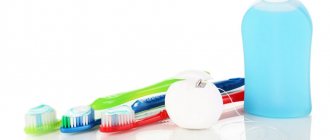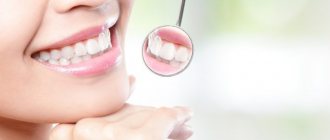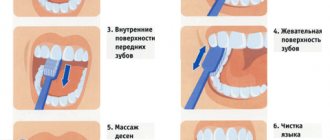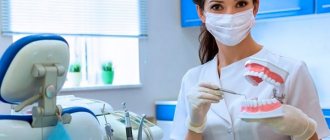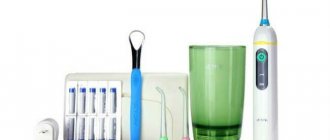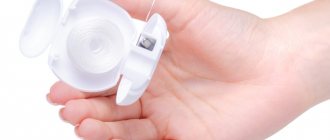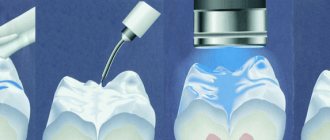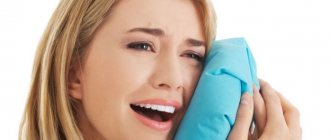A snow-white smile and the absence of bad breath allow us to create the first impression of our interlocutor.
But how to properly care for your teeth so that they look perfect if your oral health is far from ideal?
First, you should go to the store and buy a toothbrush that will effectively cope with its task and will not scratch the enamel .
Today we’ll talk about how to choose the right hygiene tool with soft bristles.
Distinctive features of a soft toothbrush
Keep in mind! If you are an adult with dental problems: a soft toothbrush is what you need.
The plastic bristle gently cleanses the enamel without causing discomfort or provoking inflammatory complications.
However, such bristles cannot penetrate the narrow interdental spaces .
The product marked soft or medium has a stiffer bristle and is suitable for people with a healthy oral cavity.
In any case, you can use dental floss to clean hard-to-reach areas .
Indications for using a soft bristle brush
This hygiene item is not suitable for everyone, and in some cases it does not fully do its job.
It is worth noting! Soft dental appliances are ideal for:
- babies learning to care for their first teeth;
- children during the period of replacement of milk teeth with permanent ones (10-12 years);
- people with poor blood clotting (diabetics);
- adults with sensitive, easily damaged enamel ;
- people with various oral diseases (periodontitis, gingivitis, stomatitis, periodontal disease);
- patients with tooth mobility syndrome.
Also, a soft toothbrush is ideal for adults with a history of erosive lesions or wedge-shaped defect .
Dentists recommend buying soft toothbrushes for children under 10 years of age.
This is due to the imperfection of dental tissues and the vulnerability of the mucous membrane.
Hard fibers can cause damage, leading to more serious consequences.
For older people, a soft-bristle toothbrush is ideal..
Know! Over time, the body wears out, and this directly affects the gums: they become loose and bleed at the slightest damage.
How to determine hardness by marking?
For the convenience of the consumer, the manufacturer labels its product in a certain way.
To choose a product with soft pile, it is not necessary to determine its hardness to the touch.
Guided by labeling , and not appearance, dental care item
- Sensitive . A device with this marking is equipped with very soft bristles . It gently removes plaque without damaging tooth enamel. Suitable for young children or adults suffering from periodontal disease. A soft brush is also good for cleaning sensitive teeth. However, you should consult your dentist before use.
- Soft . This product is suitable for elderly people and diabetics. They are also recommended for use by patients with oral diseases and pregnant women with gingivitis. It is important to use the instrument using a special technique that eliminates pressure on weakened tissues.
- Medium. This marking indicates medium-hard bristles . Well suited for people with healthy teeth.
- Hard. Model with stiff bristles : good for experienced smokers and coffee lovers. It is effective in removing dark stains on teeth, but is not suitable for daily use. If your teeth are sensitive, it is strictly forbidden to use it.
- Extra-hard. Products with similar markings are designed for cleaning dentures , bridges and braces. Such hard bristles can cause irreparable harm to living teeth.
Stay up to date! Knowing the meaning of each marking when choosing a brush that is suitable for your teeth will not be difficult and will save time.
Hydrogen peroxide solution
A 3% peroxide solution will also help make your toothbrush softer. I found one like this at home. That’s why I had a chance to test it too. The task was extremely difficult. In my bins I found an unused brush from about 88-90. The condition is good, but the bristles turned out to be so hard that even if I ran them over my finger, I felt some discomfort. Imagining that this horror awaited my gums, I decided not to tempt fate.
Hydrogen peroxide
The advantage of peroxide is that it acts very quickly. 2-3 minutes is enough for most cases. Leave the brush in the glass for no longer than 5 minutes.
After this, rinse the bristles thoroughly under running hot water. You can use it. This procedure is usually sufficient to effectively soften the stubble.
Medium and Soft brushes
Initially buy brushes labeled Medium and Soft. Hard brushes can cause bleeding gums and even increased tooth sensitivity (read more here). If you have areas of enamel demineralization, you can only use soft brushes.
Toothbrushes
Kinds
Today there are several types of brushes for delicate dental care.
Each type has its own advantages and disadvantages . In any case, the choice remains with the consumer.
Regular
The length and shape of the ends of the pile and the number of tufts are an important selection point.
Sharp bristles are suitable for removing plaque in hard-to-reach places , but people with fragile enamel and weakened gums should not buy them.
Dental appliances labeled soft or sensitive are the right choice in this case. Their soft bristles are rounded and avoid scratching.
Note! For daily dental care, it is better to choose a soft brush with frequent bristles.
Combined
These dental instruments are available both conventional and electric. Their heads are equipped with soft bristles on one side and hard (elongated) bristles on the other.
Products of this kind are quite
effective and at the same time practically safe.
Electrical
They have an original design and are multifunctional .
Under the influence of current, the head of this model rotates intensively, which allows you to effectively remove plaque without driving it under the gum .
However, electric toothbrushes can damage sensitive enamel and gum tissue . To prevent this from happening, the kit comes with a nozzle with soft bristles.
When the heads wear out, you can replace them with new ones.
Ultrasonic
Know! These toothbrushes are similar in appearance to electric ones. They are a new word in technology and have not yet become widespread.
The impact occurs due to low-frequency wave vibrations, which effectively remove the oldest plaque.
Ultrasonic attachments
are strictly contraindicated for: pregnant women , people with neoplasms in the oral cavity, persons with impaired keratinization of the mucous epithelium .
Ionic
Brushes of this kind have appeared quite recently. The operating principle is based on the rotation of a rod coated with titanium dioxide molecules.
When it reacts with liquid (saliva), the substance attracts hydrogen ions . are the ones who kill pathogenic bacteria and eliminate the acidic environment.
An ionic toothbrush allows you to save on the purchase of toothpaste.
Important to remember! It is contraindicated for smokers: nicotine, which reacts with hydrogen ions, has a destructive effect on the mucous membrane.
For cancer patients, as well as people with oral fluid deficiency syndrome, the use of this brush is not recommended.
How to make a toothbrush soft: recommendations
People who respect themselves and others are raised from childhood to constantly monitor and care for their teeth and mouth. They know that beautiful white teeth and pleasant breath affect health, personal life, and help build a successful career.
And in order for everything to always be in order in your mouth, you need to brush your teeth regularly - this has been known since childhood. The most popular item for oral care is an ordinary toothbrush.
Parents teach them to use it from a very early age. However, even they do not always know the criteria for choosing a much-needed tool.
They often do not know how to care for it and how often to change it.
Those who do not know the answers to these simple and important questions are very likely to risk damaging both their tooth enamel and gums. There is a high risk of getting a bunch of incurable diseases, and not only the mouth, but also other organs will be affected. To prevent this from happening, you should pay attention to some nuances when buying a toothbrush.
Brush selection methods
Typically, toothbrushes are purchased in modern perfume stores or pharmacies. When choosing, many people look at price and appearance and focus only on them, but these are by no means the main indicators. What should you pay attention to, how to choose correctly?
The first factor that you should take a close look at is the material used to make the bristles. There is an opinion that natural bristles are the best option. But this is far from true. Bacteria accumulate on it, leading to oral diseases. The best one is artificial: it has harder fibers, and the tips do not scratch the enamel, destroying it.
Information about the stiffness of the bristles is written on the packaging or the brush itself. According to the degree of hardness, brushes can be
- Very soft. Recommended for little ones or those with extremely sensitive teeth.
- Soft. Designed for older children 6–13 years old, recommended for adults with oral health problems
- Average. Good for teenagers.
- Tough. These brushes are used by adults with absolutely healthy teeth. Before use, it is recommended to consult a dentist, otherwise there is a risk of damage to the gums and enamel.
Using water
How to make a toothbrush soft? Often people purchase a brush with the required parameters, but after some time it becomes too hard, rubs the gums and causes discomfort. What can you do in this case, without running back to the store for a new copy? There are several tools that can make your toothbrush soft and brushing your teeth a pleasant and comfortable experience.
The easiest and most affordable way to soften a brush is with ordinary tap water. How to do it? Follow the instructions below:
- Under running hot water - there is absolutely no need for it to be boiling water. Otherwise, the plastic bristles will simply melt. You need to hold it with the bristles up for several (2-3) minutes.
- Then put hot water in a glass or jar and leave the brush there for 5–7 hours. The best thing is to do this in the evening after brushing your teeth before going to bed.
- In the morning, when you start brushing your teeth, you may find that the bristles have become soft.
Another way to soften your toothbrush is to use hydrogen peroxide. It is best to take a three percent solution. This is usually present in the first aid kit of anyone who takes care of their health.
Peroxide is poured into a glass or mug one third full, and a brush is placed in it for about 5–7 minutes. Then it is thoroughly washed. That's it, now you can use it.
Rinse aid
Surely a considerable number of people use mouthwash. It can also be a good option for softening your toothbrush.
This is done as follows:
Half a glass of rinse aid is poured - this amount is enough for the brush head to be completely immersed in it. After which a brush is placed in the solution. Depending on the stiffness of the bristles, the duration of the event ranges from two to three minutes to half an hour. The effectiveness of this technique has long been tested and proven - the villi will become soft and pleasant to the teeth.
Vinegar
Many people soften their paint brushes by soaking them in vinegar. If this method softens paint brushes, then it will work for toothbrushes. Another method to make your toothbrush soft is to soak it in a vinegar solution or pure vinegar. Any will do - table, apple or wine. But, as a rule, most people have a regular dining room in their kitchen.
How to do it?
- Vinegar is poured into a vessel (preferably transparent). You don't need a lot - just enough to completely hide the stubble.
- The dishes are placed in the microwave and heated - it is not necessary to boil, just make the liquid warm.
- Dip a brush into vinegar and leave for half an hour.
- After the appointed time, the brush is pulled out and rinsed under running water.
- To achieve a better effect, the bristles can be kneaded with your hands.
Aloe vera
Another way to make your toothbrush soft is to use aloe vera extract. It is usually used to moisturize and soften the skin. It will also quite successfully soften the bristles of the brush.
The procedure is carried out in three stages:
- The glass is filled one third with extract.
- Place the brush in the dish so that the head is completely hidden.
- After fifteen minutes, the brush is pulled out and rinsed.
That's it, she's ready to brush her teeth again.
Common salt
How to make a toothbrush soft at home? There is another very accessible and simple way. In order to try it, you will need simple table salt:
- A thick saline solution is made - the more salt, the better.
- A brush is dipped into the solution and left for several hours. You can leave it overnight.
- In the morning, the brush is washed and used for its intended purpose. After such a “bath” she will become soft and pleasant.
A little conclusion
We looked at several ways to make your toothbrush soft. Many methods have been invented, but the ones described are available to everyone. They do not require enormous costs - the ingredients are cheap or completely free. The main thing is to remember that people with snow-white, healthy teeth smile more often. This means they live happier and longer.
How to make it soft at home?
If you accidentally purchased a hard toothbrush that doesn’t suit you and causes a lot of discomfort, you can soften it in several ways:
- Through hot water. To do this, you need to hold it under running water at 40-50˚C or soak it in a glass. Steep boiling water is not suitable for this purpose, as the synthetic bristles may melt and the brush will become unusable.
- Hydrogen peroxide. This method is the fastest and most effective. To do this, you need to put the toothbrush in a glass with a 3% peroxide solution so that it covers the head with the bristles. After 5 minutes, you can take it out and rinse it with running water and safely use it.
- Aloe Vera gel. This product effectively softens the skin and can be used with a toothbrush for the same purpose. The method of application does not differ from the version with hydrogen peroxide, however, it should be kept in the gel for at least 10 minutes.
- Tooth rinse. These hygiene products have antibacterial properties and will also help soften the hard bristles of your toothbrush. The components contained in the rinse aid can restore old, dried out fibers. To do this, you need to fill the glass halfway with the product, lower the toothbrush into it and wait the required amount of time. The hardest pile becomes soft in half an hour.
Ways to soften at home
Many people have experienced in practice that they do not feel the desired effect when purchasing soft or medium-hard brushes. When brushing your teeth, they damage your gums and cause bleeding. This can be avoided. Several folk remedies to make your toothbrush even softer and the brushing process more enjoyable:
READ ALSO: How to do professional teeth cleaning at home
- using tap hot or warm boiled water,
- use of mouth rinses,
- hydrogen peroxide solution,
- aloe vera.
By water
There are several ways to soften a brush:
- Turn on the hot water. It doesn’t have to be boiling water – just a water temperature suitable for the body. Rinse your toothbrush for 10 minutes.
- Then you need to fill a container with water of the same temperature and leave the brush in it overnight. Touch the bristles - they have become softer.
- Boil water in a kettle. Cool the boiling water to a temperature suitable for the body. Next, perform the manipulations described above. If the water is too hot, it may cause the toothbrush to become deformed.
Using mouthwash
You need to pour mouthwash into the glass, but not to the brim - 100 ml is enough. The main thing is that the rinse completely covers the bristles. Using this method, you can soften old, dry brushes that have not been used for a long time. The effectiveness of this method has long been proven - at home it is possible to soften the brush with rinse aid.
Hydrogen peroxide solution
The method is also effective in making the toothbrush soft. A 3 percent hydrogen peroxide solution is suitable. The advantage of using it is that it saves time and money, because it is very cheap and can be found in any housewife’s medicine cabinet. It is enough to fill the container one third with peroxide solution and leave the brush in it for about 5 minutes. After this procedure, you need to rinse it thoroughly. It is now ready to use.
Review of the most popular models
You should know! There are many high-quality toothbrushes on the modern consumer market.
Here are the most popular models equipped with soft bristles:
- Exceed by Oral-B. Polyamide bristles are arranged in a special way, which allows them to penetrate into the most difficult to reach places. On the back of the head there is a special surface for cleansing the mucous membranes of the cheeks and tongue. The handle has rubberized inserts for ease of use.
- SPLAT Professional Sensitive. The bristles on this brush model have rounded ends and are divided into 4 parts. This eliminates injury to weakened gums and sensitive tooth surfaces. Each fiber is treated with silver ions, which has a disinfecting effect. This brush delicately removes plaque without scratching the cavity tissues.
- LACALUT Sensitive. The pile of this model is made of nylon threads impregnated with silver ions. The rounded bristles do not scratch the enamel and do not injure the gums. This brush is ideal for young children and people with sensitive teeth.
- Colgate 360 SensitivePro–Relieve. This model is equipped with the finest bristles, between which there are rubber cups. This allows you to gently clean and polish your tooth enamel. The elongated bristles penetrate into the interdental spaces and remove the smallest particles of food. On the back of the head there is a soft brush for cleaning the tongue, which reduces the growth of pathogenic microorganisms in the mouth.
- Jordan Target Sensitive. The thickness of the bristles of this model is only 0.01 mm, which allows them to effectively clean even the back surface of the teeth. The brush is good for people with various oral diseases and those who wear braces. The compact and ergonomic handle is comfortable to hold during use.
- Silka Favorite. It is distinguished by its versatility due to the originality of its design. Two-level nylon bristles allow for thorough cleaning of the gingival groove, gently massaging the gums, and the beveled lower fibers carefully remove plaque. There is a special ledge for hard-to-reach areas. The handle has a thumb ridge.
Remember! If you suffer from oral diseases and want to purchase a special toothbrush: be sure to consult your dentist.
